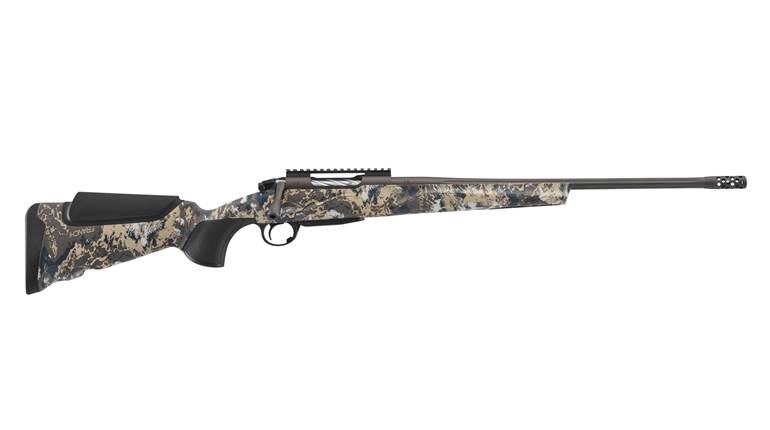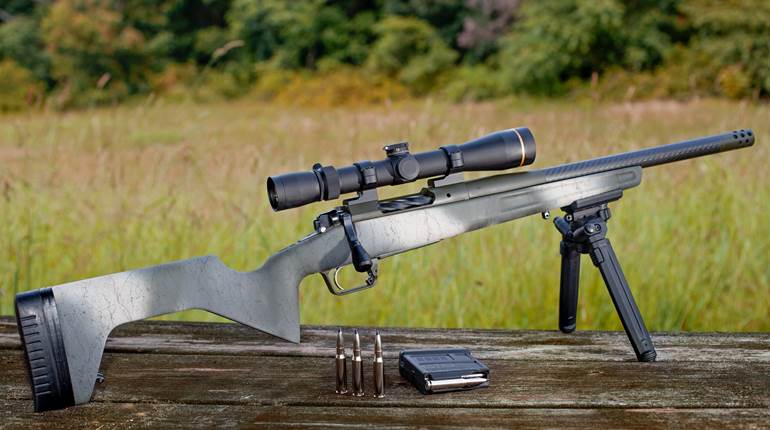
All in all, the past few years have been pretty good for high-power rifle shooters: F-Class shooting has continued to grow in popularity; Hornady’s 6.5 Creedmoor cartridge was introduced in 2008; and now, Creedmoor Sports of Oceanside, Calif., has come out with a new purpose-built high-power rifle, the Creedmoor Sports Rifle (CSR-1).
The rifle was developed by Dennis DeMille, Creedmoor Sports general manager, former National High Power and National Service Rifle Champion, and two-time All Marine Corps Rifle champion. DeMille was also instrumental in establishing the performance objectives for the 6.5 Creedmoor cartridge. He collaborated with custom action maker John Pierce and stock designer Gary Eliseo to produce a rifle that would satisfy even the most discriminating competitor.
DeMille had a number of specific design objectives for the CSR-1: extreme accuracy, exceptionally smooth bolt operation, a completely adjustable stock, a detachable magazine, the ability to handle cartridges from the .223 Rem. to .308 Win., and both right- and left-hand models. The new rifle was to be of bolt-action design, for maximum accuracy, and was to be combined with a modern aluminum modular stock having ergonomic touches borrowed from AR-15 match rifles.
Pierce supplied a 1.36-inch-diameter, two-lug stainless steel round turnbolt action with a helically fluted bolt and a bolt handle threaded for different types of knobs. The head of the 0.698-inch-diameter bolt is of conventional design, with a protruding nose, removable plunger ejector, Sako-style claw extractor, 0.135-inch gas port, and two stout lugs in the Remington pattern. In the rear is a Remington-style bolt shroud.
Threaded to the receiver ring is a 28-inch-long Broughton stainless-steel barrel in a medium-heavy contour. At the muzzle, the barrel steps down to 0.750 inches in diameter for a length of 1 inch for the attachment of front iron sights, and enlarges to 0.840 inches just beyond that. A recessed crown protects the 5CR rifling, which is cut in a five-groove, right-hand twist. Twist rates depend upon the chambering. Currently offered are .223 Rem., 6 BR, 6x47 mm, 6 XC, 6.5 Creedmoor or .308 Win.
The CSR’s barreled action is set into a Gary Eliseo modular aluminum stock, which consists of four components. The main component is a 2-inch-diameter action sleeve, which surrounds the receiver and is rigidly affixed to it via four set screws. The sleeve features cutouts for the ejection port, trigger pins and serial number. Attached to the front of the sleeve is a round, ventilated AR-15-style handguard 12 1/4-inches long and 2 1/4-inches in diameter. This can be rotated 15 degrees in either direction from vertical, allowing the shooter to employ whatever level of cant desired. The underside of the handguard is slotted to accommodate accessories, such as the supplied handstop with a quick-detachable sling swivel cup. Also available, for F-Class or benchrest shooting, is an optional 3-inch-wide bag rider plate for use with a front tripod rest.
On the bottom of the action sleeve is a housing for the trigger, magazine well and pistol grip. This housing accepts most AR-15 pistol grips. A button on the right side of this housing, just forward of the trigger guard, releases the CSR’s five-round magazine, and a round thumbrest is provided just above the trigger.
The fourth and final component of the stock, the multi-adjustable buttstock, fits over the rear of the action sleeve and is retained by a spring-loaded detent and a knurled wheel. The buttstock is adjustable in just about every way possible. Length of pull can be varied over nearly a 3-inch range, from 11 3/4 inches to 14 11/16 inches; the cheekpiece can be raised some 0.4 of an inch by means of a thumbwheel; and the buttplate can be adjusted for vertical position and offset. The buttplate additionally has provision for the attachment of one or two cylindrical 4.8-ounce weights.
Atop the action sleeve is a 10-inch-long aluminum Picatinny rail with a 15-m.o.a. forward cant, which facilitates long-range shooting with a scope. No sights are provided, but Creedmoor Sports offers a sight package consisting of a Phoenix Top Mount rear sight with 1/4-minute adjustments, a Tubb T2K Ladder front sight, and Gehmann adjustable irises front and rear.
To a competitive shooter, a gun’s trigger is of critical importance. The CSR-1 features the excellent CG X-Treme trigger, a four-lever design with pull weights of 300 to 1,800 grams (approximately 10.5 ounces to 4 pounds). In addition to adjustments for weight, overtravel and trigger position, the unit can also be set for either single-stage or two-stage operation. In the two-stage mode, sear engagement and first- and second-stage weight can be adjusted. A Remington-style two-position safety is supplied with the trigger.
The CSR-1 single-column, five-round magazine is unusual in that it does not completely enclose the cartridges. Instead, the box surrounds the case body only, leaving the bullets protruding out of the front. The cartridges are fully protected, however, once the magazine is in the rifle. On the plus side, the unique magazine design allows the shooter to adjust the vertical position of the magazine feed lips, and thus the position of the top round in relation to the rifle’s feed ramp and chamber. Each CSR-1 is provided with two magazines and a sled for single cartridge loading.
We received a production sample of the CSR-1, chambered in 6.5 Creedmoor. When we worked the action and dry-fired the gun, our impression was of a smooth, precise mechanism. Bolt lift and turndown were smooth and light, enabling the shooter to work the bolt without breaking form, particularly important during rapid-fire stages. Quick bolt manipulation was possible without binding in the receiver, even when lateral pressure was applied on the bolt at full retraction.
It is worth mentioning that Hornady has updated the 6.5 Creedmoor cartridge somewhat. While there are still two target-specific loads, with the 120- and 140-grain A-MAX bullets, Hornady changed the powder in the lighter-bullet load from H4350 to Varget, producing improved accuracy. We mounted a Nightforce NXS 5.5-22x56 mm scope and tested the gun using both 120- and 140-grain factory 6.5 Creedmoor ammunition at 100 yards. Front support was provided by a Sinclair tripod rest, while a Protektor bag was used in the rear.
Velocities were slightly lower than published factory figures. The accuracy we achieved was excellent, particularly considering the windy conditions and the fact that our test rifle’s round handguard and adjustable buttstock were not ideally set up for benchrest shooting. Five-shot groups with the 120-grain load averaged 0.44 inches, and 0.52 inches with the 140-grain load. This was an impressive performance with a factory cartridge and factory rifle, and is on a par with the best performance we have observed with custom rifles in this cartridge. Even better accuracy might be obtained with carefully crafted handloads.
We let several experienced high-power shooters handle the rifle, and all were impressed with the smoothness of the action, the adjustable buttstock, the crispness of the trigger and the overall feel of the gun.
Recoil with the 6.5 Creedmoor is light and was negligible in the 14-pound CSR-1. The trigger, in particular—set to 1 pound, 4 ounces—was a joy to shoot, and magazine function was flawless. We encountered no malfunctions of any kind.
There is a strong resemblance between the CSR-1 and the renowned Tubb T2K rifle. DeMille freely gives credit to the T2K as helping to inspire the CSR-1, as David Tubb’s brainchild was the first production rifle purpose-built to fully meet the needs of high-power and long-range shooters. The T2K had a combination of ergonomics, balance, accuracy and just plain shootability difficult if not impossible for other rifles to equal. With several national championships and records too numerous to mention, it’s difficult to argue with the T2K’s success. DeMille set the current national 200-yard rapid-fire record and won the 2005 National Championships, using a T2K.
While DeMille retained elements of the T2K, the CSR-1 offers additional features, such as the option of left-handed operation, the ability to fire .223 Rem. ammunition, a 15-m.o.a. Picatinny sight/scope rail, the previously mentioned tunable magazine, and a somewhat more economical price.
In sum, the Creedmoor Sports CSR-1 is a top-grade rifle for across-the-course or long-range competition. Made with only the best components, its accuracy will equal that of any custom rifle, yet it offers features heretofore found on no other match gun than the T2K. And the SSR-1 has some new tricks of its own. With either rifle, a serious competitive rifle shooter won’t go wrong.
Manufacturer: Creedmoor Sports, Inc.; (800) 273-3366; www.creedmoorsports.com
Caliber: .223 Rem., 6x47 mm, 6BR, 6 XC, .308 Win. and 6.5 Creedmoor (tested)
Action Type: Bolt-action, center-fire repeating rifle
Receiver: Stainless steel
Barrel: 28"
Rifling: Five-groove, 1:8" RH twist (6.5 Creedmoor)
Magazine: Five-round aluminum box
Sights: None supplied; 10"-long, 15-m.o.a. Picatinny rail for scope or iron sight mounting
Trigger: Two-stage, 1¼-lb. pull
Stock: Fully adjustable: length of pull, 11¾" to 1411⁄16"; drop at heel/comb, 0.8" (cheekpiece fully lowered)
Overall Length: 48½" (buttstock fully extended)
Weight: 13 lbs., 4 ozs. (without sights, magazine or accessory weights); 14 lbs., 12 ozs. (with sights, magazine and extra weights)
Accessories: Extra five-round magazine; single-loading sled; two 4.8-oz. buttstock weights; handstop; instructions; optional iron sight package
Suggested Retail Price: $3,750; add $750 for iron sight package






































